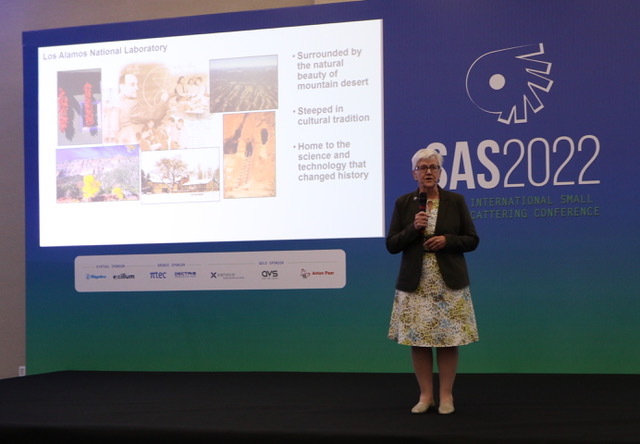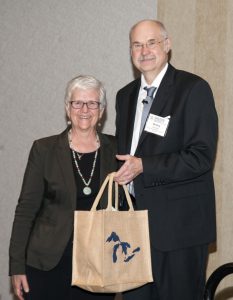The Guinier Prize
The International Union of Crystallography (IUCr) Commission on Small-Angle Scattering, together with the organising committee of the Triennial Conference on Small-Angle Scattering presents a prize of US$5000 in honour of the great scientist and 'father' of small-angle scattering, Professor André Guinier.
The Guinier Prize is given for lifetime achievement, a major breakthrough or an outstanding contribution to the field of small-angle scattering.

2022 - Jill Trewhella (School of Life and Environmental Sciences, The University of Sydney, Australia)
The 2022 Guinier Prize was awarded to Jill Trewhella at the SAS2022 meeting in Campinas, Brazil with the following citation:

Dmitri Svergun receives his 2018 Guinier Prize from the IUCr SAS Commission's Jill Trewhella.
2018 - Dmitri Svergun (EMBL, c/o DESY, Germany)
At the SAS2018 meeting in Traverse City, MI, USA, the 2018 Guinier Prize was awarded to Dmitri Svergun for the following:
(i) his seminal contributions of innovative methods for the interpretation of small-angle scattering (SAS) data generally, and particularly with respect to biomolecular SAS;
(ii) his sustained effort over several decades to establish and support the most comprehensive suite of data analysis tools for biomolecular SAS in the form of the ATSAS program package;
(iii) his leadership in instrument development at EMBL-Hamburg, from DORIS to PETRA III; and
(iv) his leadership of and service to the field through community-focused projects and education.
In sum, Dmitri’s contributions reflect lifetime achievement as well as outstanding individual contributions to the field of SAS that are most worthy of recognition by the awarding of SAS’s most prestigious prize.
Dmitri’s presentation at the award ceremony honoured those who were influential mentors and teachers and the many collaborators, students and post docs he has worked with, beginning with his time as a graduate student at Moscow State University and the Institute of Crystallography in Moscow where he subsequently was appointed to a research position in 1980 to pursue his interests in biomolecular SAS, through his time when he came to Germany in various visiting and guest capacities at the GKSS Geesthacht and then at the EMBL unit in Hamburg where he eventually moved full time, becoming a group leader and then senior scientist. It was at the EMBL that Dmitri was able to fully realize his vision for biomolecular SAS, in the process building an outstanding team of theoretical, computational and experimental researchers, many of whom have continued in the field with distinction, many of whom you have heard from at this meeting.
Dmitri’s seminal contributions are broad and impactful; there was the inclusion of perceptual criteria combined with the automated optimization of the regularization parameter to obtain stable P(r) solutions from indirect Fourier transformation of SAS data, which was quickly followed by the publication of a method to rapidly calculate SAXS profiles from atomic coordinates. This was a major breakthrough in that it provided the missing link between high-resolution structures and low-resolution solution data - and remained without any competitor for ~15 years before new approaches were developed. A series of further developments gave us a general method for restoring the shape of a scattering object from the solution SAS profile, the means to evaluate the uniqueness of the shape determination and a measure of similarity of models, rigid-body modelling for when atomic coordinates for domain and/or subunit structures are available, options for including flexible linkers, and finally modelling intrinsically flexible proteins in terms of conformational ensembles.
These innovations and advances form the core of the ATSAS program package for SAS data manipulation, analysis, and modelling that is under continuous development and enhancement and is used extensively in biomolecular SAS community - its popularity is no doubt not only due to its versatility, but also the fact that it is well-documented, freely available for download for academic users, accessible via an online service, and users are supported via the online SaxieR forum or as needed via collaborative engagement.
Data analysis tools are of little value without high quality data, and so in addition to this work, Dmitri ensured the continued the tradition of innovation at the SAS facilities in Hamburg first at DORIS and now Petra III with automation of sample handling, in-line sample purification and characterization, and on-the-fly analyses.
Dmitri’s body of work is documented in more than 500 research publications, including two books, the most recent being a must-have comprehensive reference for both experienced and aspiring biomolecular small-angle scatterers.
But Dmitri’s impact extends well beyond the boundaries of SAS. Recognizing the value of combining complementary data to advance our molecular understanding of biology, Dmitri’s educational outreach soon moved beyond his popular Hamburg-based purely practical SAS courses to organizing global lecture series for structural biology that combined SAS with complementary biophysical methods that he took to China, Korea, Brazil, India, Taiwan and Singapore (so far), spreading the power of SAS with good practices to other scientific communities and helping to grow the number of SAS users all over the world. His ongoing collaborative work with the world-wide Protein Data Bank on initiatives to support hybrid methods for solving complex structures provide a crucial foundation for SAS to contribute to this important emerging frontier.
Jill Trewhella
Consultant, IUCr Commission on Small-Angle Scattering
2015 - Sow Hsin Chen (MIT, USA)
Sow Hsin Chen from the Department of Nuclear Science and Engineering of the Massachusetts Institute of Technology (MIT) received the 2015 Guinier Prize at the SAS2015 meeting in Berlin. On Thursday afternoon, September 17, he delivered a plenary talk covering just a few of his many contributions to science and to the field of small-angle scattering methods development and applications in fundamental studies of soft condensed matter. He described his most recent work using small-angle neutron scattering to measure and discover a density minimum in deeply supercooled water that further demonstrates the plausibility of the existence of the second critical point in supercooled water. He also spoke about many of his long-lasting contributions in the field of small-angle scattering, such as:
- the first use of neutron contrast variation to elucidate and propose the microstructure of SDS micelles and reversed micelles;
- formulation of the so-called decoupling approximation to handle the calculation of the small-angle neutron scattering intensity distribution of interacting non-spherical particles in solution and to correct for the effect of polydispersity;
- a fractal approach to calculating the scattering intensity distribution of protein-detergent complexes in solution;
- devising a contrast variation method to measure the average mean curvature of surfactant films in a bi-continuous micro-emulsion;
- proposing and implementing a Clipped Random Wave Model which enabled the successful measurement of the average Gaussian Curvature of the surfactant film.
The Guinier prize recognizes either lifetime achievement, or a major breakthrough, or an outstanding contribution to the field of small-angle scattering. As Sow Hsin Chen’s plenary unfolded it was clear to all present that he met all three of these criteria. As he acknowledged the contributions of his many students, post docs and collaborators throughout his talk, it was evident that he had educated and inspired a whole generation of today's research leaders in his field of study.
After his plenary talk, at the Conference banquet, accompanied by his wife Ching-chih Chen, Professor Chen was presented with his prize and some small gifts to remember Berlin and the occasion.
Jill Trewhella
Chair, IUCr Commission on Small-Angle Scattering
Obituary
Sow-Hsin-Chen (1935-2021)These pages are maintained by the Commission Last updated: 12 Jun 2023

